September 28, 2018
Air Date: September 28, 2018
FULL SHOW
SEGMENTS
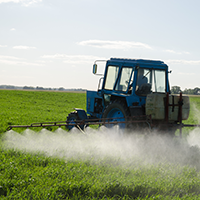
Billion Dollar Losses Related to Roundup
View the page for this story
Pharmaceutical and chemical giant Bayer has shed some $20 Billion in market value in the weeks after a California court ordered it to pay $289 million in damages to plaintiff Dewayne Lee Johnson related to the herbicide Roundup made by Bayer-owned Monsanto. Jurors found that Monsanto had acted with malice and negligence in failing to warn Johnson, who is now suffering from late-stage non-Hodgkins lymphoma, about the cancer risks associated with Roundup and its key ingredient glyphosate. Journalist Carey Gillam tells Host Steve Curwood that with thousands of similar cases in the pipeline, Bayer may be on the hook for billions more, even though it merged with Monsanto just three months ago. (10:00)
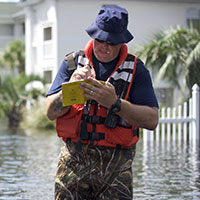
Beyond the Headlines
/ Peter DykstraView the page for this story
In this week’s trip beyond the headlines, Peter Dykstra and Host Steve Curwood take a look at the aftermath of Hurricane Florence, which damaged coal ash ponds and forced a nuclear plant shutdown but left solar power largely unscathed. And they note how time and time again along the North Carolina coast, homes in harms’ way have flooded and been rebuilt, at great cost to taxpayers. For the history lesson, they recall October of 1970, when President Nixon created the EPA and NOAA in just two days. (03:30)
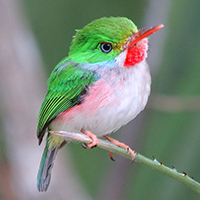
Birdnote®: The Cuban Tody, A Caribbean Jewel
/ Michael SteinView the page for this story
A “must-see” bird for anyone traveling in the West Indies, the Cuban Tody is a tiny bird with a lot of personality. In this week’s BirdNote, Michael Stein introduces us to these striking Cuban natives. (02:00)
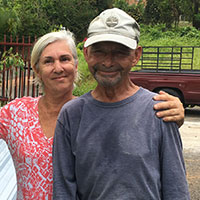
Rebuilding Puerto Rico’s Battered Farms
/ Bobby BascombView the page for this story
Despite being a lush tropical island, Puerto Rico imports nearly all of its food. Hurricane Maria brought road closures and shuttered grocery stores, leaving many Puerto Ricans with no choice but to skip meals and live on shelf stable and canned food for weeks and months. But as Living on Earth’s Bobby Bascomb reports, volunteers and farmers are working together to rebuild Puerto Rico’s small and devastated farming sector. (12:00)
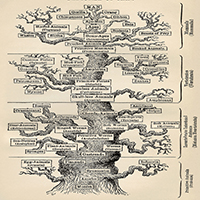
The Tangled Tree
View the page for this story
The tree of life proposed by Charles Darwin in the 19th century, depicts different forms of life diverging from one another as they evolve down through successive generations. But discoveries of new life forms and the phenomenon of horizontal gene transfer indicate life can also evolve through convergence. Author David Quammen discusses these discoveries in his new book, The Tangled Tree: A Radical New History of Life. He spoke with host Steve Curwood. (19:00)
Show Credits and Funders
Show Transcript
HOST: Steve Curwood
GUESTS: Carey Gillam, David Quammen
REPORTERS: Bobby Bascomb, Peter Dykstra, Michael Stein
[THEME]
CURWOOD: From Public Radio International – this is Living on Earth.
[THEME]
Curwood: I'm Steve Curwood,
Pharmaceutical and chemical giant Bayer has lost 20% of its market value after a jury found the herbicide Roundup caused a man’s cancer.
GILLAM: Investors were stunned by this very large verdict, $289 million, it was a unanimous decision by the jury. And of course we have thousands of more lawsuits making very similar claims that will be relying on similar evidence.
CURWOOD: What Bayer knew about the risks of Monsanto’s signature product Roundup.
Also, working to rebuild Puerto Rico’s farming sector after Hurricane Maria.
CARLO: Since the hurricane was a cyclone it brought some saltwater and sand with it. So, everything that was in its path it looks like you threw herbicide. All of our production for years of tropical trees like mango trees and passionfruit trees they all died and they all blew away.
CURWOOD: That and more this week on Living on Earth – Stick Around!
[NEWSBREAK MUSIC: Boards Of Canada “Zoetrope” from “In A Beautiful Place Out In The Country” (Warp Records 2000)]
[THEME]
Billion Dollar Losses Related to Roundup
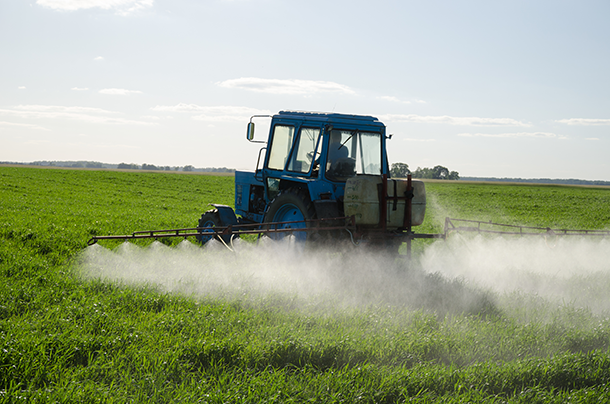
A tractor sprays farm chemicals on a field. (Photo: Aqua Mechanical, Flickr CC BY 2.0)
CURWOOD: From PRI and the Jennifer and Ted Stanley Studios at the University of Massachusetts Boston this is Living on Earth. I’m Steve Curwood.
A finding of consumer deception against Monsanto, makers of the widely used herbicide Roundup, is costing its new parent company more than $20 billion in lost market value as its stock price has tanked. In June the German pharmaceutical and chemical giant Bayer merged with Monsanto by paying over $60 billion, just 2 months before a California jury ruled unanimously in favor of Dewayne Lee Johnson. Mr. Johnson is a former school groundskeeper, and the jury agreed his non-Hodgkins lymphoma was caused by the herbicide Roundup and ordered Monsanto to pay $289 million in damages. Now Bayer has to pay those damages and the company is likely to have to pay thousands of other people who claim Roundup caused their cancers or other health problems as well. Carey Gillam, a journalist who has reported extensively on Monsanto, joins us now. Carey, welcome back to Living on Earth!
GILLAM: Thanks for having me.
CURWOOD: So, tell me why have Bayer's shares reacted so dramatically dropping what some 20 percent in just a matter of weeks?
GILLAM: Yeah, I mean Bayer shares are definitely taking a hit, and really what this is is it's the fault of the Bayer executives who did not properly warn their shareholders that this potential liability was out there. Investors were stunned by this very large verdict - $289 million - it was a unanimous decision by the jury and of course we have thousands of more lawsuits making very similar claims that will be be relied on similar evidence. I mean, potentially we're talking about billions of dollars in potential payouts and damages. At some point if these things continue to snowball and the plaintiffs continue to win, there will be settlement talks, and the numbers that I've already heard tossed around are $3 to $5 billion dollars potentially.

Bayer’s share price fell 20% in the weeks following the Dewayne Johnson v. Monsanto Company verdict. (Photo: Conan, Flickr CC BY 2.0)
CURWOOD: Of course, those are not just damages that Bayer has to worry about, but how are consumers considering this company now?
GILLAM: I mean, what you what you're seeing is sort of a continuation a building of concern around the world. You already were seeing different localities, and states and countries looking at banning glyphosate products and you now seen even more of that. Every bit of news on this causes heightened concern obviously with consumers. You're seeing some retailers talk about pulling these from their store shelves. This is resonating definitely around the world.
CURWOOD: Now, what you think the chances are that the $289 million dollars awarded to the plaintiff Dewayne Johnson could be overturned or reduced?
GILLAM: So, the legal experts that I've consulted and that are talking about this really say there's very little chance. It doesn't seem like there's a lot of legal standing for Monsanto to get this thrown out like they've asked the judge to do. They've asked for a new trial and they've also asked the judge to issue a judgment on standing to substantially reduce the damage award. But the judge was very favorable and very generous to Monsanto during the trial already and kept a lot of evidence that Monsanto didn't want in, kept a lot of that evidence out, there doesn't seem to be a lot of room for Monsanto to get this thrown out at this point.
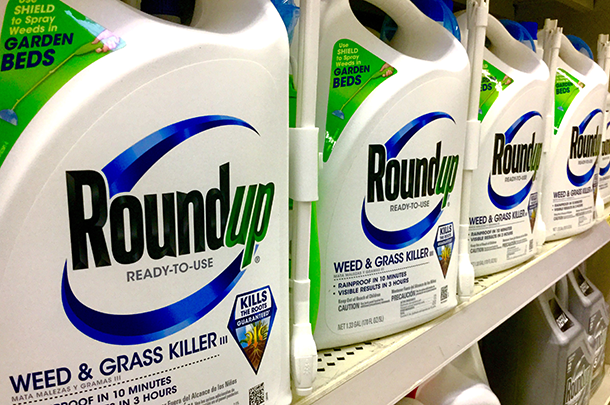
As a groundskeeper for four years in the Benicia, CA school district, plaintiff Dewayne Lee Johnson applied the herbicide Roundup to school grounds about 20 to 30 times a year. (Photo: Mike Mozart, Flickr CC BY 2.0)
CURWOOD: So, Carey what was the evidence that the plaintiffs wanted in this case that the judge said no, no, no...I'm going to honor what Monsanto wants...we won't let this in.
GILLAM: One of the key things I guess that Monsanto really did not want in there was any sort of direct comparison to the tobacco industry. As we know from litigation in the tobacco industry, we know there was very much a playbook, a strategy to deceive consumers and keep them from understanding the risks of tobacco and its connections to lung cancer. And the very same playbook, there's evidence that very same playbook has been used by Monsanto to keep consumers from understanding the risks of glyphosate herbicides. You see the same players, in fact, Monsanto's own attorney in this roundup litigation made his fame and fortune defending tobacco companies. They didn't want any of those comparisons and the judge largely sided with Monsanto on that. They didn't want people to know about a ban in Europe on one of the key ingredients in the Roundup products. The judge sided with them on that. They didn't want people to know that California had ordered companies to start putting warning labels on Roundup and other glyphosate products. The judge sided with them on that. A lot of information like that was kept from the jury and still they came up with this huge verdict against Monsanto.
CURWOOD: To what extent does this verdict say that Monsanto deceived consumers knowing that it had a problem product they put on the market?
GILLAM: The jury found not only that there was enough scientific evidence to connect these products to this individual's cancer, but that Monsanto acted with malice and negligence in refusing to warn people because, of course, there are years and years and years of scientific studies that have come out from independent scientists that do show connections between glyphosate based products and cancers and a range of other illnesses. And Monsanto and has long been aware of these. And the jury was saying they should have warned people, they should have at least given people this information. This wasn't about banning glyphosate. It was about warning consumers about known risks and, of course, Monsanto didn't do any of that. They did the opposite. They tried to suppress that information, tried to hide it and tried to discredit scientists who raised those warning bells.
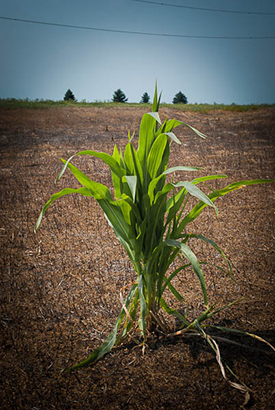
A single Roundup-Ready corn plant appears to be thriving in a demonstration field that has been heavily sprayed with the glyphosate-based Roundup herbicide. But pesticide-resistant weeds are starting to diminish glyphosate’s effectiveness. (Photo: Matthew Traucht, Flickr CC BY-NC-ND 2.0)
CURWOOD: You mention negligence, but you also said malice. To what extent did the judge and jury find that Monsanto had acted with malice in distributing and encouraging the use of Roundup?
GILLAM: Well, that was part of the questionnaire. That was part of what the jury had to determine. They really seemed to be moved by the fact that this individual Lee Johnson called Monsanto. He was very worried he'd been diagnosed with cancer. He was worried about whether or not he should continue his job, should continue working to spray these products and Monsanto never warned him even after these international cancer scientists said there was a connection. They never got back to him and they never warned him. The jury really seemed to take issue with that.
CURWOOD: Now, Bayer CEO Werner Baumann is facing questions as to whether he and the other executives really did a full scale assessment probably evaluated the risks of taking over Monsanto. How much trouble could he be in?
GILLAM: Well, there's definitely talk of shareholder lawsuits against Bayer and against the executives for not really doing their due diligence and for not warning investors properly. It doesn't seem like they really were on top of this at all. I mean, anybody who's been paying even a little bit of attention knew that there was this potential for huge jury award certainly he in his conference call with investors right after the verdict, he didn't even have the proper classification from the Center National Cancer Agency. He said it was rated a possible carcinogen. Well, that's not true. It was rated a probable carcinogen. He didn't have a clear grasp of the facts as he was trying to reassure investors, and that tells us he didn't have a clear grasp of the facts going into this at all.
CURWOOD: Carey, you're saying that the Bayer executives didn't understand the science here?
GILLAM: I don't think that they were paying a lot of attention. They were relying on the assurances by Monsanto that this was really nothing to worry about, and the Bayer executives did say in this call with investors right after the verdict, they did admit and they said they didn't have a lot of visibility to Monsanto's internal documents. They only closed this deal with Monsanto in June and just really got the integration closed in August, so they're claiming they didn't have good insight at the time.
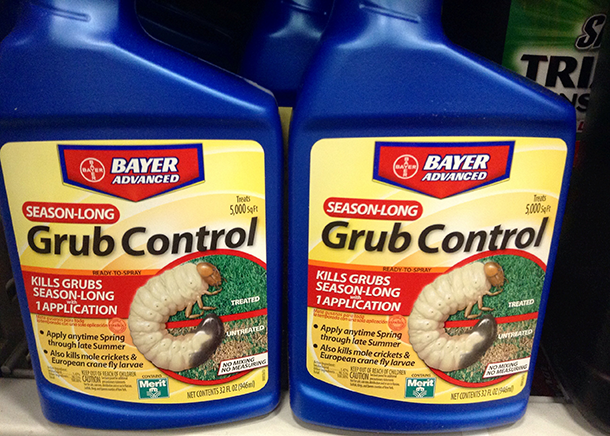
Bayer already had a strong presence in the pesticides market before purchasing Monsanto in 2018. (Photo: Mike Mozart, Flickr CC BY 2.0)
CURWOOD: So, what options if any does Bayer have to say, hey Monsanto, you really didn't disclose properly to us, we want to walk this deal back, we want to unwind this merger?
GILLAM: Well, they're certainly not talking about that at all right now, and they're showing no signs of backing away. In fact, they are saying they're going to double down and bring all of their legal strength to Bayer to try to fight this verdict and to fight the trials that are upcoming. We have several new ones, they are being scheduled for 2019, so this could go on for some time and it's certainly going to cost a lot of money at least in in legal fees, for sure, and if not legal payouts.
CURWOOD: And speaking of legal fees, with this win, how soon does the plaintiff of Mr. Johnson and his attorneys get paid?
GILLAM: Well, that's that's a good question. Monsanto is appealing. The money actually gets put into an account right now with interest, and it's accruing interest on a daily basis. Mr. Johnson, my understanding is he's getting a little bit of money right now through sort of a loan against what his payout would be, but it could be a year or more before before it's really all settled. The interesting thing on this is that Mr. Johnson's attorneys had actually offered a settlement of $6 million dollars to Monsanto in April and Monsanto turned it down.
CURWOOD: Carey go amiss a journalist and author of "Whitewash: The Story of a Weed Killer, Cancer, and the Corruption of Science". Carey Gillam thanks so much for taking the time with us today.
GILLAM: Thanks for having me.
CURWOOD: We asked Bayer for a comment. They replied in part, “Bayer stands behind its glyphosate-based products and we are confident that the company will ultimately prevail in this litigation based on the extensive body of favorable science.”
You can find their entire statement on our website, LOE dot org.
Statement from Bayer
“Glyphosate-based herbicides have been used safely and successfully for over four decades worldwide and are a valuable tool to help farmers deliver crops to markets and practice sustainable farming by reducing soil tillage, soil erosion and carbon emissions. The full body of research on glyphosate and Monsanto’s glyphosate-based herbicides consists of more than 800 rigorous registration studies required by EPA, European and other regulators that found them to be safe for use. This extensive science also encompasses more than 100 studies examining the carcinogenic potential of these same substances that EPA considered relevant to its 2017 cancer risk assessment which concluded glyphosate is ‘not likely to be carcinogenic to humans,’ the agency’s most favorable rating. Notably, the largest and most recent epidemiologic study, the 2018 independent National Cancer Institute long-term study that followed over 50,000 pesticide applicators, found no association between glyphosate-based herbicides and cancer.
“The Johnson verdict is wholly at odds with over 40 years of real-world use, an extensive body of scientific data and analysis, including in-depth reviews by regulatory authorities in the U.S. and EU, and approvals in 160 countries, which support the conclusion that glyphosate-based herbicides are safe for use and do not cause cancer in humans. As the admissions by plaintiff’s experts at trial made clear, the epidemiological evidence presented fell well below the causation standard required under California law.”
“The number of cases in this litigation may rise and fall over time, but these numbers are not indicative of the merits of the claims.
“Bayer stands behind its glyphosate-based products and we are confident that the company will ultimately prevail in this litigation based on the extensive body of favorable science.”
Related links:
- Wall Street Journal | “Bayer Steps Up Legal Fight Over Weed Killer Blamed for Cancer”
- CBS News | “Man dying of cancer says $289 million Monsanto verdict not ‘in vain’”
- LOE’s coverage of anti-trust concerns over recent ag company mergers
- Carey Gillam is an investigative journalist and the author of Whitewash: The Story of a Weed Killer, Cancer, and the Corruption of Science
[MUSIC: Natraj, “Miato Bebeviawo” on Song Of the Swan, West African traditional/arr.Scarff and Mat Maneri, Galloping Goat Records]
CURWOOD: Coming up – our feathered friends start heading south. Stay tuned to Living on Earth.
ANNOUNCER: Support for Living on Earth comes from the Gordon and Betty Moore Foundation and from a friend of Sailors for the Sea, working with boaters to restore ocean health.
[MUSIC: Natraj, “The Ride, Part 1, Introduction” on Song Of the Swan, by Scarff/arr.Scarff, Jerry Leake, Galloping Goat Records]
Beyond the Headlines
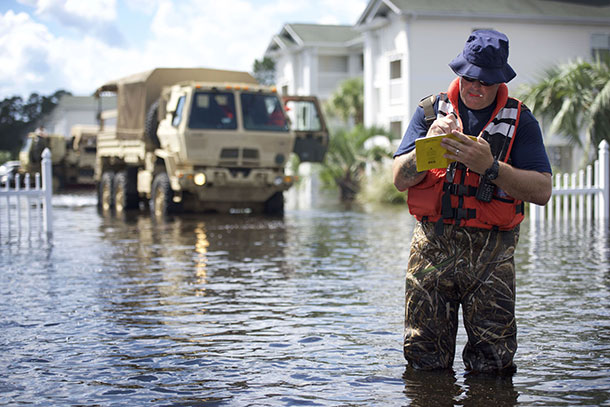
Taxpayers subsidize homes to be rebuilt over and over again in the same flood-prone place, thanks to the National Flood Insurance Program. (Photo: Petty Officer 1st Class Jon-Paul Rios, U.S. Coast Guard, Flickr CC BY-NC-ND 2.0)
CURWOOD: So, let’s take a look behind the headlines now with Peter Dykstra. He’s an editor with Environmental Health News, that’s EHN.org, DailyClimate.org. On the line now from Atlanta - hey there Peter, how are you doing?
DYKSTRA: Doing all right, Steve, hope everything is well up there. I want to talk a lot about Hurricane Florence and some of its aftermath. You know, North Carolina is the number two state, believe it or not, in solar energy production, behind only California. And there was actually some relatively good news out of Hurricane Florence – the solar industry says it weathered the storm fairly well, even if all of the power lines that carry electricity didn’t.
CURWOOD: What was the secret, did they just tie them down?
DYKSTRA: Well, there’s one Duke Energy facility that says that they are able to automatically able to lock their solar panels in place, and the rest of it was just that the panels were constructed well enough that the category one winds that came ashore in North Carolina weren’t enough to do any damage. Unlike some of Duke Energy’s other means of power for the Carolinas, there was a coal ash dam that ruptured and sent toxic coal ash into a waterway. Also the Brunswick nuclear plant near the city of Wilmington was pre-emptively shut down, and it looked like solar energy was one of, if not the most reliable source of energy through the storm.
CURWOOD: Now what about wind?
DYKSTRA: There’s only one large industrial-scale wind farm in the state of North Carolina. They said they did well during the storm also.
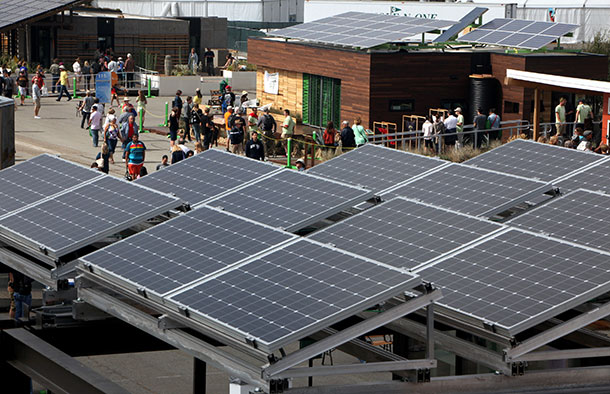
North Carolina is second only to California in the pace of growth of its solar industry. In the aftermath of Hurricane Florence, solar panels held up remarkably well, while coal and nuclear facilities faced difficulties. (Photo: Stefano Paltera, U.S. Department of Energy Solar Decathalon, Flickr CC BY-ND 2.0)
CURWOOD: So, sustainability sustained itself through the storm. What else do you have on Florence?
DYKSTRA: The National Flood Insurance Program often pays time and time again for homes that are in harm’s way from flooding to be rebuilt or repaired. One example is the town of Belhaven, which is on North Carolina’s outer banks. 1,600 people, and over the decades, that community has received $13.4 million dollars in payouts from the Flood Insurance Program. Another example is an individual house in the town of Nag’s Head, on the Outer Banks. The house was demolished a few years ago, but before it was demolished, it had received payments from the National Flood Insurance Program 28 times.
CURWOOD: Oh, my. Hey, what do you see in the history vault this week?
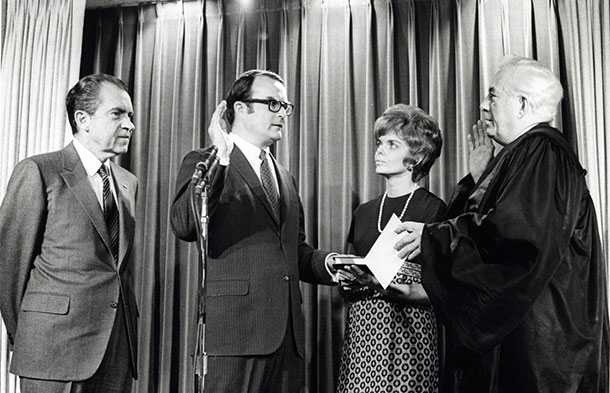
William Ruckelshaus was sworn in as the first Administrator of the U.S. EPA in 1970. President Richard Nixon, who created the agency, is shown overseeing the ceremony. (Photo: Richard M. Nixon Presidential Library, Wikimedia Commons public domain)
DYKSTRA: Oh, we’ve got a two-day event on October 2nd and 3rd of the year 1970. President Richard Nixon went on an environmental rampage and created two agencies. On October 2nd in ’70, he created the EPA. The following day, he created the National Oceanic and Atmospheric Administration, NOAA. Two of the backbone agencies for government environmental protection for the past almost half-century.
CURWOOD: And the government hadn’t been doing this stuff before, or?
DYKSTRA: They’d been doing a lot of it, but it was divided up into small offices, in different government agencies around Washington and around the country. And what Nixon did administratively is bring a lot of this work under two new roofs of NOAA and the EPA.
CURWOOD: Peter Dykstra is with Environmental Health News. That’s EHN.org, and DailyClimate.org. Thanks, Peter, we’ll talk to you again real soon.
DYKSTRA: All right, Steve, thanks a lot, talk to you soon.
CURWOOD: There’s more on these stories at our website, LOE.org.
Related links:
- Inside Climate News | “Solar Energy Largely Unscathed by Hurricane Florence’s Wind and Rain”
- Bloomberg | “North Carolina Flooding Soaks Federal Taxpayers All Over Again”
- On October 2nd, 1970, President Nixon authorized the creation of the EPA
- The following day, October 3rd, 1970, Nixon created NOAA
[CUTAWAY MUSIC: Natraj, “Miato Bebeviawo” on Song Of the Swan, West African traditional/arr.Scarff and Mat Maneri, Galloping Goat Records]
Birdnote®: The Cuban Tody, A Caribbean Jewel
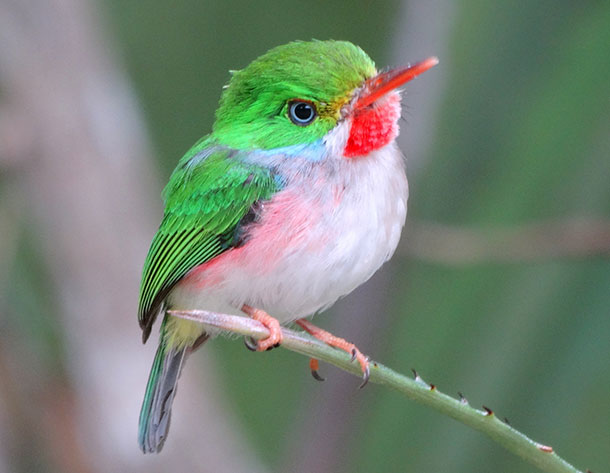
About the size of a hummingbird, the Cuban Tody sports brilliant, multicolored plumage. (Photo: Sandra Minotti)
CURWOOD: It’s Living on Earth. I’m Steve Curwood.
[MUSIC – BIRDNOTE THEME]
CURWOOD: In the woodlands of the West Indies lives the Cuban Tody, a tiny bird no bigger than a cigar. But as Michael Stein tells us in today’s BirdNote, the little Tody has a voracious appetite for flying insects.
[Call of Cuban Tody]
This staccato call comes from the throat of a Cuban Tody. [Call of Cuban Tody]…
A bird that’s almost indescribably cute – and the top of the "must-see" list of any birder heading for the West Indies. Because although it’s not much bigger than a hum-mingbird, a Cuban Tody packs a lot of pizzazz into its tiny body.
[Music]
It’s big-headed. Short-tailed. Brilliant leaf-green with a geranium-red throat. And as if that weren’t enough to be noticed, the Cuban species features a touch of blue on the sides of its throat. Its long, flattened bill looks like it’s built for insect-catching. And indeed it is.
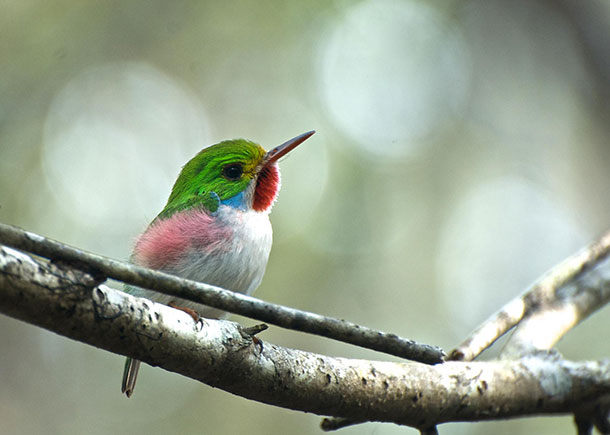
Living in the woodlands of Cuba, todies make whirring noises with their wings when hunting for insects. (Photo: Rodrigo Medel)
In woodlands throughout the island of Cuba, Todies are terrific foragers. In fact, their Puerto Rican cousins have been known to catch up to one or two insects a minute, hunting from dawn to dusk. Their wings make an audible whirring sound each time they do this, and you may find a Tody just by listening for that sound.
[Call of Cuban Tody and music]
I’m Michael Stein.
###
Written by Dennis Paulson
Music and bird sounds provided by The Macaulay Library of Natural Sounds at the Cornell Lab of Orni-thology, Ithaca, New York. 'Traditional Cuban Music' 62981 recorded on the roof of the Libertad Hotel, Santiago by Gregory F Budney; Cuban Tody 112183 recorded by Gregory F Budney.
BirdNote's theme music was composed and played by Nancy Rumbel and John Kessler.
Producer: John Kessler
Executive Producer: Dominic Black
Associate Producer: Ellen Blackstone
© 2018 Tune In to Nature.org September 2018 Narrator: Michael Stein
https://birdnote.org/show/cuban-tody
CURWOOD: For pictures, migrate over to our website L-O-E dot O-R-G
Related links:
- Learn more on the BirdNote website
- The Cuban Tody at The Cornell Lab of Ornithology
[MUSIC: Jane Ira Bloom, “Emily & Her Atoms” on Wild Lines: Improvising Emily Dickinson, by Jane Ira Bloom, Outline Records]
Rebuilding Puerto Rico’s Battered Farms
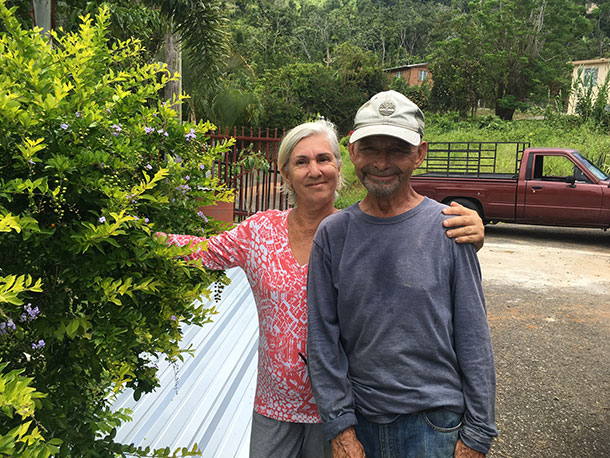
Farmers Domingo and Nilsa Romano are grateful for the physical and emotional support of the volunteers with the NGO El Departamento de la Comida. (Photo: Bobby Bascomb)
CURWOOD: This week we continue our series looking at how Puerto Rico is recovering after Hurricane Maria laid waste to the island in September, 2017. We’ve looked at the resiliency of the corals, the forests, the drinking water system, and the people themselves. Now Living on Earth Bobby Bascomb checks in on the farming sector.
She went to Puerto Rico nine months after the storm and met some small farmers who lived through it and were still working to rebuild.
BASCOMB: Even before hurricane Maria uprooted trees and people, Puerto Rico imported roughly 85% of its food. After the storm that number shot up to about 95% imported food, if you could get it. Many people were forced to skip meals and eat shelf stable and canned food for months.
[MARKET SOUNDS]
Nine months after the storm one of the only places to find locally grown food on the island is farmer’s markets like the Saturday market in Rincon on Puerto Rico’s west coast.
MAN: Do you have kale?
CAROLO: Yes, we have kale. You want baby kale or dinosaur kale?
MAN: Dinosaur kale? How’s that?
Sonia Carlo’s nearby farm is slowly recovering from the storm. Today she’s brought pineapple, papaya, mushrooms, and the kale she’s explaining to a customer.

The Puerto Rican and American flags painted on the corner of a building in Rincon, Puerto Rico. The Puerto Rican dependence on imported food can be attributed, in part, to US economic incentives. (Photo: Bobby Bascomb)
CARLO: …. They’re two for five, so if you want both of them…
MAN: I like kale. What’s a single go for?
CARLO: Three, or two for five.
MAN: You got change?
CARLO: Yeah.
MAN: I’ll take…I’ll take both. Why not?
CARLO: Alright. One and one? Thank you.
BASCOMB: Sonia’s bright smile makes her a natural salesperson.
CARLO: It's a good time to be at the market right now.
BASCOMB: Sonia says things are just starting to turn around for her family and the farm. They are finally harvesting again and her farm to table restaurant, Sana, opened just a few weeks ago. But hurricane Maria was devastating for them. The storm destroyed her home. She had to send her 3 children to Florida to live with family while she and her husband, living in their car, rebuilt the battered farm.
CARLO: We got really trashed. All of our production for years of tropical trees like mango trees and passionfruit trees, they all died and they all were blown away. We had trees that were a hundred years old and you know, totally perished. Since the hurricane was a cyclone, it brought some salt water and some sand with it, so everything that was in its path, it looks like you threw herbicide.
BASCOMB: Across the island tall fruit trees were the most heavily damaged food crop. Root vegetables that could hide underground did ok. Ground plants like pineapples were among the first to recover and fast growing vegetables like salad greens were easy enough. After the hurricane visitors came to Puerto Rico with their suitcases full of seeds to donate to farmers. Sonia says they actually could have started growing again relatively quickly.
CARLO: But since we didn't have any electricity, we couldn't pump water out and we didn't have any gas, so we were unable to grow food because we don't have gas to pull out the water from the water pump. You know, it was just - you know trying to scrape up anything. Waiting ten hours for gas, just to grow food. It was very uncertain.
[SFX LATIN MUSIC IN GROCERY STORE]
BASCOMB: Grocery stores are open again on the island. But visit a grocery store on Puerto Rico and you’ll be hard pressed to find anything supplied by local farmers. I went shopping at an Amigo chain grocery store, which is owned by Walmart.
[SFX GROCERY STORE SOUNDS]
BASCOMB: Let’s see there’s pineapple from Costa Rica, coconuts from the Dominican Republic. Honeydew melon from Guatemala. Over here there’s more watermelon, chopped up – [gasp]. Aha! I found some watermelon from Puerto Rico. These are watermelon already cut up into pieces. The whole watermelon came from someplace else.
[GROCERY SOUNDS]
BASCOMB: To understand why this lush tropical island with year round sunshine and rain imports nearly all of its food you need to go back to the 1940s and a US initiative called Operation Bootstrap.
MARICHAL: With the colonization of the US there was a movement to get people out of their farms and into the cities.
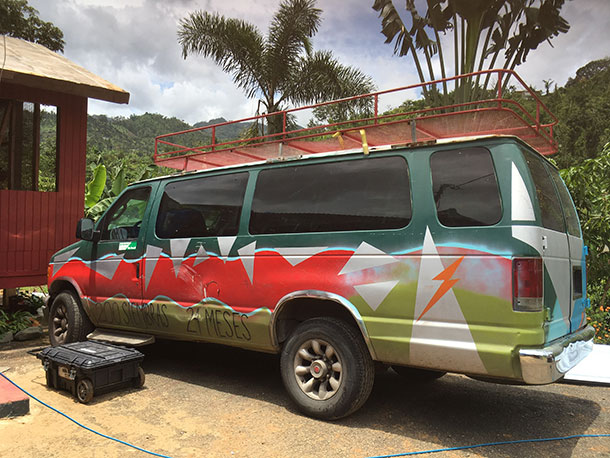
El Departamento de la Comida volunteers travel to farms in a bus, locally known as a guagua, which carries all the equipment they will need for their work. (Photo: Bobby Bascomb)
BASCOMB: Adnelly Marichal is the documentarian for the Resilience Fund in Puerto Rico. She says Operation Bootstrap transformed Puerto Rico from a largely agrarian economy to one based on manufacturing and tourism. They did that with a patchwork of government tax incentives and access to US markets. The farming that remained was not on the household level but on a larger, industrial scale.
MARICHAL: Now suddenly, it’s about making money so therefore you need to grow things like sugar and coffee and that’s great but those are not things that people can eat.
BASCOMB: And the food that is imported to Puerto Rico is on average 20% more expensive than in the US. That can be attributed at least in part to the Jones Act of 1920 which says any item imported to Puerto Rico must be carried on a US vessel. So, if Puerto Rico wants to import let’s say tomatoes from its neighbor, the Dominican Republic, those tomatoes must first go to the US mainland more than 800 miles away. They get put on a US boat, and then travel back those same 800 plus miles to Puerto Rico.
MARICHAL: So, it both makes the food more expensive and less nutritious by the time it gets here it’s been on a boat much longer than it has to be. It just creates a much longer timeline.
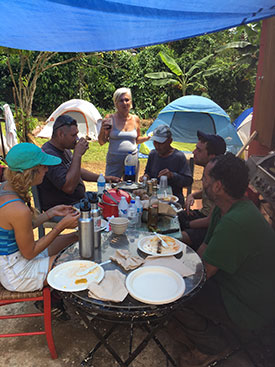
Volunteers eating lunch before they get back to work fixing the Romano’s roof. (Photo: Bobby Bascomb)
BASCOMB: One of the few agricultural areas of Puerto Rico is called Las Marias. The region is known for growing oranges for orange juice. I drove to Las Marias to meet with a small scale orange farmer.
[DRIVING SOUNDS]
Las Marias is way up in the mountains on the western half of the island. My drive is 13 miles but it took more than an hour on narrow, twisty, nausea inducing mountain roads. My GPS signal failed and I got wildly lost. It’s difficult to get here on a good day. After the hurricane it was impossible. Las Marias was cut off from the rest of the island for 2 months and had to have supplies airlifted in by helicopter.
[CHICKEN SOUNDS]
Farmer Dominogo Antonio Romano is 75 years old and has a small farm here with his wife, Nilsa. He walks past his chicken coop and stops in front of his only orange tree that survived the hurricane.
ROMANO: Only one, tenemous una sola.
BASCOMB: He used to have 20. Before the hurricane most of Domingo’s farm was made up of coffee, mango, and orange trees. The very crops most impacted by the storm.
DOMINGO: 90% of our farm was destroyed but it was really like 100% because with the hurricane no one could come here to harvest.
BASCOMB: Near the one surviving orange tree, amid debris of tree limbs and weeds, is a small patch of vining plants.
ROMANO: (SPANISH) This is a purple yam, they are very good.
BASCOMB: Root vegetables like yams were really the only food crops that didn’t get torn away by the 155 mile an hour winds of hurricane Maria. They were one of the only food crops the Romanos could still harvest and eat after the storm. But animals in the area were also struggling to find food. Wild pigs quickly discovered the purple yams and ate most of them.
ROMANO: (ENGLISH) Before Maria, we have many. But we have nothing.
BASCOMB: Domingo and his neighbors still had months to go before the roads would be cleared or the electricity restored. He says in that time they came to rely on each other for help.
ROMANO: Before Maria, there was forest everywhere. And then, after Maria, the trees came down and we could see our neighbors and we got to know each other. After the hurricane, there was a lot of empathy between the people, and everybody helped each other. And the bees! We got to feed them. After the hurricane there were no flowers so we put out sugar water for them.
BASCOMB: His crops were destroyed and roof torn off his house. They were without running water or electricity for months. Domingo says it would have been impossible for him to rebuild alone. But he’s not alone.
[CONSTRUCTION SOUNDS]
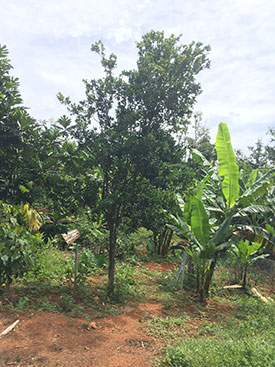
The Romano’s one remaining orange tree. (Photo: Bobby Bascomb)
5 volunteers from a grassroots non-profit group called El Departamento de la Comida, the Food Department, are here to camp out on the farm for a week and do any work that needs to be done: clear land, plant crops, fix fences and repair the roof.
[CONSTRUCTION SOUNDS]
The volunteer Food Department is organized into groups called brigades and are dispatched all over the island. As many as 20 people at a time descend on a farm for a week bringing with them seeds, tools, building supplies, and the man power to get a farm back up and running. Edan Freytes is the leader of this brigade. He says they do this work because farmers are crucial for Puerto Rico going forward.
FREYTES: the farmer is the… the agriculture is like the espina.
BASCOMB: The backbone.
FREYTES: The backbone of the country. And it’s the most damaged sector. I think it’s the sector we need more to help, because it got the worse loss.
[COOKING SOUNDS]
BASCOMB: Farmer Domingo’s wife, Nilsa, is in the kitchen cooking lunch for the volunteers… cassava root, sliced tomatoes, rice and beans. She lifts the top off a pot of soup she’s been working on since this morning.
(SPANISH)
N. ROMANO: This has pork, bread fruit, green banana, onion, pepper, cilantro, garlic.
BASCOMB: Nilsa says she’s happy to have the volunteers here. The work they are doing in a week would have taken her and her husband months. But beyond the physical help she is grateful for the emotional support and encouragement the volunteers bring.
DOMINGO: It’s very emotional for me because I was very depressed. It was a very traumatic experience. For months we were without water, electricity and a roof. And we were alone. With this group here I’m just so grateful for the support. So grateful.
BASCOMB: The volunteer Food Department has set a goal to send brigades like this to 200 farms across Puerto Rico, large and small, organic and commercial. They simply want to support domestic agriculture in any form.
[MARKET SOUNDS]
Sonia Carlo from the Rincon Farmer’s market says she had similar support, not from an organized group but friends, neighbors, and strangers volunteering their time to help her rebuild.
CARLO: What really got us through everything was the community. This, you know, we had a commitment to our community especially in Rincon people just said “what do you need, I’ll help you. What do you need, you need hands?” And we said “yeah, we need people.” “I’ll help you”. You know, and that gave us strength to keep growing and producing.
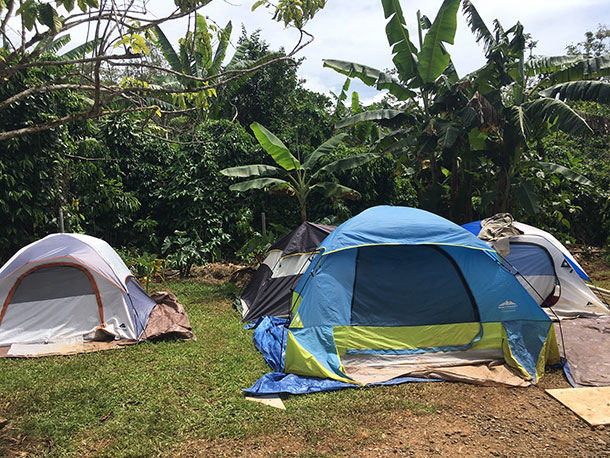
Volunteers with El Departamento de la Comida camp out in tents on a farm for up to a week to help farmers rebuild their farms. (Photo: Bobby Bascomb)
BASCOMB: And Sonia says that outpouring of support has given her a new sense of purpose to keep on farming.
CARLO: Granted, you see me standing here, I'm working seven days a week. But I'm doing it with a smile on my face, because I know it's for good. You know, it's for the good of everything. And I know this is my journey in life and this is what we're going to be doing. No matter how many hurricanes come, we’ll still bounce back. Nothing is going to keep me out. Not even a category 5 hurricane.
BASCOMB: For Living on Earth, I’m Bobby Bascomb in Rincon Puerto Rico.
Related links:
- El Departamento de la Comida
- El Fondo de Resiliencia
[MUSIC: Jane Ira Bloom, “Big Bill” on Wild Lines: Improvising Emily Dickinson, by Jane Ira Bloom, Outline Records.]
Curwood: Coming up, horizontal gene transfer and rethinking the tree of life. That’s just ahead here on Living on Earth, Stay Tuned.
ANNOUNCER: Funding for Living on Earth comes from you our listeners and United Technologies, combining passion for science with engineering to create solutions designed for sustainability in aerospace, building industries, and food refrigeration. UTC companies such as Otis, Carrier, Pratt and Whitney, and UTC Aerospace systems are helping to move the world forward. You can learn more about United Technologies by tuning into the Race to Nine Billion podcast; listen at race to nine billion dot com. That’s race to nine billion dot com. This is PRI, Public Radio International.
[CUTAWAY MUSIC: Jane Ira Bloom, “Emily and amp; Her Atoms” on Wild Lines: Improvising Emily Dickinson, by Jane Ira Bloom, Outline Records]
The Tangled Tree

The “tree of life” as depicted by Ernst Haeckel, a German scientist who helped popularize Charles Darwin’s theories of evolution. In this English version of Haeckel’s tree from his book The Evolution of Man (1879), “man” sits at the top of the tree, the pinnacle of evolution. (Photo: Ernst Haeckel, American Philosophical Society Museum, Wikimedia commons, public domain).
CURWOOD: It’s Living on Earth. I’m Steve Curwood.
About a hundred and sixty years ago Charles Darwin wrote Origin of the Species, postulating that life on earth evolved from ancient species that diverged over time, rather like a tree branches from a single trunk. Scientists focused how diverging species inherited characteristics, as genes were passed and sometimes mutated from one generation to the next.
Well, we know life can be complicated, so we should not be surprised that evolution is not just based on the tree of life and inherited genetics. We learned in 1970’s that there are creatures that are kind of between single celled bacteria and multi cellular creatures like humans, a category of life called archaea that could hold the key to how life got started on earth. And now science has discovered horizontal gene transfer, which is changes genomes via sideways infection, sometimes across species.
Author David Quammen tells the story of this new understanding of evolution in his book, The Tangled Tree: A Radical New History of Life. David joins us from Bozeman, Montana. Welcome to LOE!
QUAMMEN: Thank you, Steve. Very good to be with you.
CURWOOD: So, what is the story that you set out to tell?
QUAMMEN: Well, it's the story of the tree of life as the image of evolutionary history on Earth, which goes back to Darwin and the way that image, that tree, has been radically challenged and radically revised in the last 40 years because of discoveries from genome sequencing, a kind of evidence that Darwin and most biologists in the 20th century didn't have, and those challenges have been astonishing, counterintuitive, and re-shaped what we thought we knew about the history of life on Earth.

A portrait of Carl Woese shows the microbiologist in his later years, photographed at the University of Illinois where he was faculty member of the Institute for Genomic Biology and where he made his discovery of the third kingdom of life, the Archaea. (Photo: Don Hamerman, Wikimedia commons, CC BY 3.0)
CURWOOD: To summarize, I think it's fair to say a big takeaway here is that what we think of as species, what we think of as individuals, and for that matter, the whole tree of life where evolution shows species neatly divergent from its origins, well, is not exactly right. Why is that?
QUAMMEN: That's putting it politely. I say at the end of the book after having told the stories of these people and their discoveries, that this whole revolution has challenged three categorical ideas, and that's the idea of species, the idea of individual and the idea of the tree of life. The idea of a species, that it's a unitary thing, it's a population of creatures that are similar to one another, and they interbreed with one another and only with one another. The idea of an individual, there is an individual named Rufus the brown dog, there is an individual named Charles Robert Darwin, there's an individual Steve Curwood, David Quammen, and we are unitary and discreet, and thirdly the tree of life represents the history of life on Earth. It is a tree shaped history, and it turns out that all three of those ideas, those categories, are wrong in important ways.
CURWOOD: Now, let's talk for a moment. Yours is a story of people, scientists trying to understand life and how it has evolved, how it continues to evolve. Tell me about some of the characters in your story, especially Carl Woese.
QUAMMEN: Yes, so I came across this fellow early on in my own discovery of the subject. Carl Woese, a microbiologist at the University of Illinois, who came out of nowhere and suddenly in November 3, 1977, appeared on the front page of The New York Times, above the fold, a picture of him and a story about his discovery of a third kingdom of life on Earth, a separate form of life that was unknown to exist before that. Before that we thought there were basically two kinds of life bacteria and everything else. Bacteria were simple cells. Everything else was composed of complex cells with cell nuclei, animals, plants, fungi, humans. And Woese came along and said, now wait a minute, I've discovered a third form, and that was the beginning of a sequence of discoveries that he essentially triggered that have led to this new understanding.
CURWOOD: And by the way, what was it that he discovered what was between bacteria and multicellular organisms?
QUAMMEN: There was a group of organisms now known as the archaea, archaea as in archaeology suggesting old, because it was thought that they were the oldest form of life on Earth maybe. These were creatures that had been taken for bacteria for decades and decades. Ever since people started looking at microbes through microscopes, they thought that these things were bacteria. Woese started sequencing their genomes, and lo and behold, he said no, these things are not bacteria. If you look at their genomes, they're not only distinct from bacteria, but they're more similar to us, to humans, to all animals, to plants than they are to bacteria. They are radically distinct, and so he announced in a scientific paper and the press announced in headlines that he had discovered a separate form of life, the third major kingdom.
CURWOOD: Now, by the way, about this kingdom that Carl Woese discovered, this are pretty tough characters aren't they? They're in hotspots, very extreme temperatures, that sort of thing.
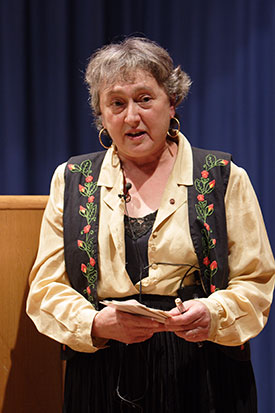
Lynn Margulis, an American microbiologist, revived the theory of what she called “endosymbiosis” which asserted that mitochondria were descended from captured bacteria. When Carl Woese’s methods came along, her theory was proven correct. (Photo: Javier Pedreira, Wikimedia commons, CC BY 2.0)
QUAMMEN: Well, these creatures, the archaea, at first they seem to live entirely in extreme environments, as you said, hot springs in Yellowstone Park, thermal vents at the bottom of the ocean, highly acidic environments. More and more as scientists discovered ways to sequence DNA just out of the wild, they have discovered these creatures live in a lot of different environments, not all of which are extreme. But one of the groups of extremity loving archaeans live near vents at the bottom of the Atlantic Ocean almost 10,000 feet down between Norway and Iceland, and those archaea are called Lokiarchaea and it's now thought that they, in fact, are the descendants of our original ancestors, that we, all complex creatures, grew out of an ancestor that more closely resembled one of these archeans living in a vent at the bottom of the Atlantic Ocean, than having come from anywhere else. That those are, how to put it, they're the descendants of our ultimate ancestors that we come from archaea and not from say the bacterial side of the tree of life.
CURWOOD: Then raises the question maybe they came from someplace else because if they're really tough noogies, they might have survived interstellar space.
QUAMMEN: That's why NASA funded Carl Woese's work. His original funder, when he discovered the archaea, one of his funders was the National Aeronautics and Space Administration. Why? Because they thought that his work might shed light on the problem of exobiology, the possibility of the existence of life on other planets, other star systems, other places around the universe.
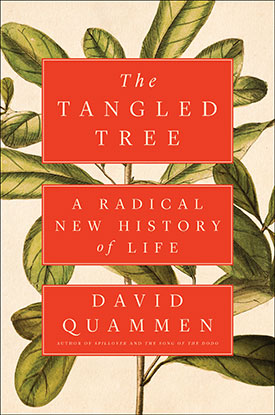
The cover of David Quammen’s new book, The Tangled Tree. (Photo: Courtesy of Simon and Schuster)
CURWOOD: Tell me a bit more about Carl Woese, the man.
QUAMMEN: He was a biophysicist. He was trained at Amherst and then at Yale in biophysics, that was his Ph D, and then he went to work for the General Electric labs in Schenectady, New York. They hired him as a research molecular biologist, and he really had no idea what they wanted him to be doing. He sat in a lab in Schenectady for a few years noodling around and trying to make some important discoveries. He was always interested in pure science and the deep questions: What is the shape of the early history of life and the history of life since then. Eventually he was hired away to the University of Illinois where he could be a cranky crotchety professor that didn't spend much time with undergraduates. He was a terrible lecturer. He was reclusive. He didn't participate in faculty committees. He was just this brilliant grouch who could be wonderful to his students, could be a fine generous mentor, but could also be this total reclusive grump, a complicated man with different sides to him, which is part of what attracted me to him as a character, as the central character of the book. The other thing that attracted me was that I quickly saw that he's probably the most important biologist of the 20th century that nobody has ever heard of.
CURWOOD: So, one could say that convergence is a major theme of your book, and of course, in the Darwinian tradition where genes passed vertically from parent to offspring, we draw trees to represent these movements and it's the limbs on the tree only diverge from other branches. But, David, if the tree of life is not actually a tree, how might we best describe evolution based on what you've researched and written about here?
QUAMMEN: Well, some people say we should think of a web and not a tree of life because as you say convergence is very very important. A network of life. One fella suggested a circle of life, and yet the tree is still mostly right. It captures some big patterns, but there are exceptions to those patterns. The tree image was valuable to Darwin and the people who followed him because it represented the divergence that has occurred through the history of life. One lineage diverging into two lineages, one limb into two branches etcetera, and species diverging from one another. All of this divergence that lead to the diversity of life that we see on Earth now. But it's not just a matter of divergence. The discoveries that flowed from from Woese's work and his methodology, including things like the prevalence of a phenomenon called horizontal gene transfer - genes moving sideways across boundaries - those represented convergence. And so, the real history of life is a history of lots and lots of divergence complicated by a lesser but very significant amount of convergence - genes moving sideways, branches of life coming back together - and that's why I titled my book "The Tangled Tree".
CURWOOD: So, let's talk about horizontal gene transfer please describe this phenomenon for us and and how revolutionary a discovery it was.
QUAMMEN: Right. Well, when I first came across this probably back in 2013. I had written three, maybe four books about evolution before that and I had never heard of horizontal gene transfer. So, suddenly I came across it reading some scientific article or a blog or something in 2013, and my first reaction was, what, that's impossible, that's just not supposed to happen. I mean, yes, if you have two very similar species closely related, then sometimes individuals mate and hybrids are born and occasionally those hybrids are even fertile. So, the two closely related species may overlap and connect a bit, but that's not what we're talking about. We're talking about genes moving across broader gaps from one unrelated species of life into another. Horizontally, as opposed to vertically, which represents parents to offspring, ancestors to progeny. This was sideways movement of genes, so that a gene from a bacterium is showing up in an animal, a gene from a virus is showing up in an animal, a gene from one kind of animal is showing up in a completely different kind of animal. How can that happen? The short answer is infection. One scientist called this infective heredity.

Many species of archaea thrive in extreme environments, such as hot springs like Grand Prismatic Spring in Yellowstone National Park. (Photo: Jim Peaco, National Park Service, Wikimedia commons, public domain)
CURWOOD: How accurate is it to say that bacteria can become part of our cells in the form of mitochondria?
QUAMMEN: Well, mitochondria are an important part of the story. Mitochondria are these little organs, they call them organelles in cell biology. They're the organs in ourselves that package energy. We have thousands of them in each of our cells, and they're completely essential for packaging energy that our complex cells can use. So, where do those mitochondria come from?
Well, it turns out they are descended from captured bacteria. They have DNA in them, but it's essentially not human DNA, it's bacterial DNA. What happened? Well, about two billion years ago, one ancestor cell of all complex creatures either swallowed or was infected by a single bacterial particle, and instead of digesting it or rejecting it, it accepted it and that bacterial particle stayed replicated, adapted, changed, became symbiotic with the host cell that it was in and eventually evolved into mitochondria. This was an idea proposed back in 1967 by the great microbiologist Lynn Margolis and everybody thought she was crazy, and most people thought she was crazy. And then when Carl Woese's methodology came along, she was proved right.
CURWOOD: Now when Lynne Margolis came up with what was her concept? She called it something like genetic chimera.
QUAMMEN: Yes, she called all creatures chimera, meaning composites of different kinds. The Greek chimera is a combination of say a lion and a hawk. She revived this theory that she called endosymbiosis, and part of the theory was this idea that our mitochondria are captured bacteria, and she also argued that there are organelles in plants cells called chloroplasts that do the photosynthesis. She argued those too were captured bacteria. And then people came along in the footsteps of Carl Woese and said, well, let's test that idea by sequencing the DNA in mitochondria, these organelles in chloroplast, and when they sequenced the DNA those organs contained DNA themselves, apart from the DNA in the nucleus of our cells. People sequence that DNA and they said, son of a gun, this is a bacterial genome inside the mitochondria. These things are captured bacteria, the descendants of anciently captured bacteria.
CURWOOD: So, these days then there is though a fair amount of horizontal gene transfer happening, but it's mostly what among the bacteria themselves?
QUAMMEN: Yes, it seems to be very common among bacteria, almost routine among bacteria. They are, as I said, simple cells. They don't have their genomes locked up inside cell nuclei. Their genome is a single strand of DNA, and it floats free in the cell, and occasionally one bacterium sends out a little tube almost like a penis to another bacterium, and DNA travels through that tube into the other bacterial particle. But it doesn't have to be the same species of bacteria, which is what makes this horizontal gene transfer so scrambling, so consequential.
CURWOOD: And how is this related to antibiotic resistance?
QUAMMEN: This is essential to understanding the spread of antibiotic resistance around the planet as a global public health problem. This kind of transfer that I just described, with the tube that goes out, and a little loop of DNA being sent through that tube from one kind of bacterium into another, this, scientists now understand is what accounts for the speedy spread of antibiotic resistance around the planet. What do I mean by that? Well, resistance to one kind of antibiotic can evolve gradually in one kind of bacterium by the old fashioned mutation incremental mutations, the old fashioned Darwinian mechanism, and the natural selection works on that, and then after a period of time, well, this bacteria A is resistant to antibiotics, one, but now we know that by horizontal gene transfer once that's happened bacteria A can pass that resistance gene to bacterial B C D F G in an instant by horizontal gene transfer, and can receive other resistant genes the same way. In fact, there are now whole packets of genes for resistance to four or five different kinds of antibiotic that can be passed in an instant from one kind of bacteria into a completely different kind. So, the problem rises by Darwinian mutation and natural selection, and it spreads lightning fast around the planet by horizontal gene transfer.
CURWOOD: Oh my, so David, I want to go to this question of just who are we, who or what is David Quammen, who or what is Steve Curwood. What is an individual if we're not the sort of individuals we thought we were looking at Darwin's thinking of evolution?
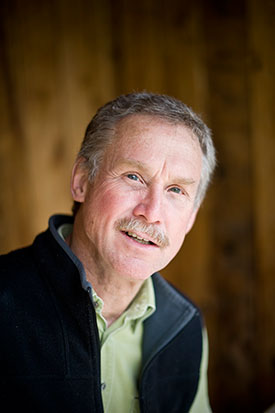
David Quammen is an award-winning science writer and journalist. (Photo: Lynn Donaldson)
QUAMMEN: Well, Lynn Margolis would say we are chimera. Others would say we're mosaics. We are individuals, as we've said before, but our individualness, our individuality is a compoundment of other creatures and DNA that has come to us by several different routes. One route is through lineal descent through all of our line of animal ancestors, but DNA has also come into us by horizontal gene transfer, come into us sideways, come into us by infection, so that, Steve, you and I and every other human now, our genomes are eight percent viral, for instance, eight percent of our genome is viral DNA that has come in sideways by infection, plus, we contain bacterial DNA in the form of all the mitochondria and ourselves, plus we probably contain other bits of bacterial DNA that has been brought into our genomes by infected heredity, by horizontal gene transfer. So, who are we? Well, we are individuals in quotation marks who represent the phenomenon of mixing as well as the phenomenon of linear evolution that have shaped life on this planet. I think that that's a humbling thought, but it's also an inspiring thought. It connects us even more closely with all other kinds of life and with the history of life on this planet.
CURWOOD: David Quammen is an award winning science writer and journalist. His book is called "The Tangled Tree", a radical new history of life. David, thanks so much for taking the time today.
QUAMMEN: Steve, thank you. I've enjoyed it.
Related link:
David Quammen’s website
[MUSIC: Fishtank Ensemble, “Mehum Mato” on Samurai Over Serbia, traditional arr. F. Martinez, self-published.]
CURWOOD: Living on Earth is produced by the World Media Foundation.
Our crew includes Naomi Arenberg, Thurston Briscoe, Savannah Christiansen, Jenni Doering, Jaime Kaiser, Don Lyman, Aynsley O’Neill, Jake Rego, Sarah Rappaport, Adelaide Chen, and Jolanda Omari. Tom Tiger engineered our show. Alison Lirish Dean composed our themes. You can hear us anytime at L-O-E dot org, iTunes and Google play- and like us, please, on our Facebook page - PRI’s Living on Earth. And we tweet from @livingonearth. I’m Steve Curwood, Thanks for listening!
ANNOUNCER: Funding for Living on Earth comes from you our listeners and from the University of Massachusetts, Boston in association with its School for the Environment, developing the next generation of environmental leaders. And from the Grantham Foundation for the Protection of the Environment, supporting strategic communications and collaboration in solving the world’s most pressing environmental problems. Support also comes from the Energy Foundation, serving the public interest by helping to build a strong clean energy economy.
ANNOUNCER 2: PRI, Public Radio International.
Living on Earth wants to hear from you!
Living on Earth
62 Calef Highway, Suite 212
Lee, NH 03861
Telephone: 617-287-4121
E-mail: comments@loe.org
Newsletter [Click here]
Donate to Living on Earth!
Living on Earth is an independent media program and relies entirely on contributions from listeners and institutions supporting public service. Please donate now to preserve an independent environmental voice.
NewsletterLiving on Earth offers a weekly delivery of the show's rundown to your mailbox. Sign up for our newsletter today!
 Sailors For The Sea: Be the change you want to sea.
Sailors For The Sea: Be the change you want to sea.
 The Grantham Foundation for the Protection of the Environment: Committed to protecting and improving the health of the global environment.
The Grantham Foundation for the Protection of the Environment: Committed to protecting and improving the health of the global environment.
 Contribute to Living on Earth and receive, as our gift to you, an archival print of one of Mark Seth Lender's extraordinary wildlife photographs. Follow the link to see Mark's current collection of photographs.
Contribute to Living on Earth and receive, as our gift to you, an archival print of one of Mark Seth Lender's extraordinary wildlife photographs. Follow the link to see Mark's current collection of photographs.
 Buy a signed copy of Mark Seth Lender's book Smeagull the Seagull & support Living on Earth
Buy a signed copy of Mark Seth Lender's book Smeagull the Seagull & support Living on Earth

